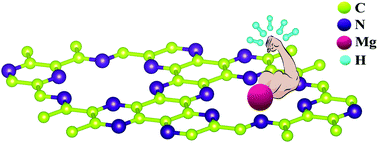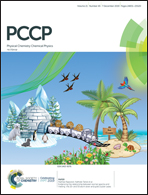Potential hydrogen storage materials from metal decorated 2D-C2N: an ab initio study†
Abstract
Two dimensional nitrogenated holey graphene (2D-C2N) is often considered as an ideal material for hydrogen storage applications owing to its lower mass density and high surface-to-volume ratio. As the interaction between H2 and pristine 2D-C2N is very weak with an adsorption energy of only 0.10 eV per H2, it is important to improve it through appropriate materials design. Using density functional theory calculations, we investigated the hydrogen storage properties of metal (M = Mg, Ca, Ti, V, Mn, Fe, Co, Ni, Cu, and Zn) decorated 2D-C2N. From this study, we found that M binding energy on 2D-C2N is greater than the cohesive energy of the respective bulk metals, indicating that the metal is strongly bonded with the 2D-C2N, which rules out the metal clustering issue. In particular, 2D-C2N with Mg decoration leads to 6.79 wt% hydrogen storage capacity with a desirable adsorption energy which is above the Department of Energy's target. The electronic structure analyses show that the Mg decoration leads to a semiconductor-to-metallic transition in 2D-C2N. Our chemical bonding analyses through partial density of states, charge density, electron localization function, charge transfer, and Bader effective charge confirm the presence of an iono-covalent character for Mg decorated 2D-C2N. This indicates that the H2 molecules are adsorbed by a polarization mechanism. Overall, our results suggest that Mg decorated 2D-C2N is a promising candidate for potential hydrogen storage applications.



 Please wait while we load your content...
Please wait while we load your content...